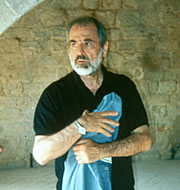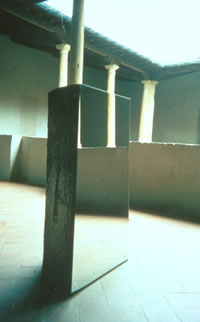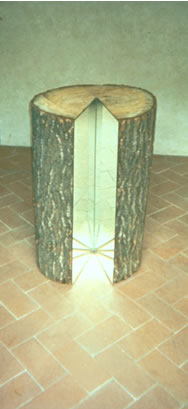 |
 The
study of the (divided and multiplicated) mirror The
study of the (divided and multiplicated) mirror
"It might seem weird, but in the beginning - that is, in the 1950’s
- I had focused all my attention upon myself, that is, on self-portrait.
To see myself I had to look into a mirror. My problem was how to transfer
my presence from the physical level into the mirror and then onto the
canvas; in other words, how to bring it into that conceptual space which
was supposed to give me an answer. In 1961, after having worked on it
for a long time, I came to a solution: I painted a canvas completely black
and then on the black I put a thick layer of paint - the canvas became
a reflecting surface. When I started painting my image on it, I was surprised
to see it facing me and coming towards me as if floating freely in the
air. For the first time, I could copy myself looking at me on the canvas
and not in the mirror standing beside it. So the two things, the canvas
and the mirror, had become one. This fact had such deep implications that
I had to start interpreting it.". This is how Michelangelo Pistoletto
explains the origin of his first works, which date back to the ten years
between the beginning of the 1950’s and the beginning of the 1960’s
and which show a male figure against a black, gold or silver compact monochromatic
background. Celant indicates the distorted silhouettes of Bacon as the
main reference point for these first works by Pistoletto; but he also
points out the neutral and almost impersonal way of displaying them employed
by Pistoletto (1). It is, as if the latter aims at making Bacon’s
anguish objective.There is only a short way from these works to the reflecting
surfaces, as the artist himself explains in his own words. "In 1962
I transformed the reflecting canvas into a steel mirror and then, looking
for a shape which had the same qualities of the image reflected in the
mirror, I found that the closest thing resembling it was the photograph.
By means of this solution, the picture involved the onlooker letting him/her
enter into the picture, which became his/her portrait as well. "The
mirror is a boundary where the finite and the infinite come together and
merge, where past and present, art and life are united. From the point
of view of the figure caught within the picture, the work looks always
the same; but if we consider the flow of images which it catches in a
series of unsteady moments, then it is always different. As Celant remarks, in the work there is a swaying between representation
and existence, without a definite choice being made. Ultimately, the mirror
is always a latent self-portrait: the first image that was reflected in
it was that of the artist. Self-portrait is the mirror-stage in painting,
it is the moment of the identification, of the acceptance of the image.
But the self looking at the mirror sees itself as divided and multiplied;
the mirror becomes the place where there is a splitting, a division; what
the artist sees in the mirror is not a metaphor or an analogical image
but rather a continuous flow of metonymies, a series of portions of life
which move on beyond the limits of the picture. At this point, Pistoletto
decided to invade the external space which he had previously tried to
comprehend within the picture ("so it happened that I was thrown
into the crowd, that is, into the situation that we all experience in
our everyday life. This is the outcoming of my discovery of the world
surrounding my self-portrait in the mirror."). Divisione e moltiplicazione
dello specchio ("Division and Multiplication of the Mirror")
is the title of a few works dating back to the 1970’s in which the
mirror is split and put together into different unities that are often
arranged at an angle, so that new possibilities of reflecting and refracting
are created. To realize his project for the balcony of the cloister of
Palazzo Minucci-Solaini, the Pinacoteca of the ancient city of Volterra,
Pistoletto drew inspiration precisely from this concept. The project is
a series of five differently arranged tree-trunks. It is a strange coincidence
that on the invitation for the exhibition there was a series of five trees
which was taken from a work by Beato Angelico, the artist who tried to
establish a correspondence between the Creator, the Creation and the creatures
and who expressed the analogies exhisting between nature and culture by
means, for instance, of a parallelism between the tree and the human body.
These secret coincidences are an essential part of the spirit of the exhibition,
which aims at re-establishing a relationship between the artists and the
cities, renewing the ties to the artistic tradition of the past while
thinking of the future. The first tree-trunk is divided into two halves
and has a reflecting surface on the inside; the second one is cut at a
90° angle and is covered by two mirrors which look as if they were
four, due to refraction. This reflection ranging from one to the infinite
is present even where we can’t see it, inside matter. Just like the
mind is within the body, so reflection exists within the tree, within
nature’s body. The more the cutting angle becomes narrow, the more
the mirror gets multiplied, until the tree-trunk closes again letting
the two mirrors join and coincide - and the reflection disappears. The
two mirrors reflecting each other create again a cylider inside that corresponds
to the external cylindrical shape: on the outside we have a virtual reflection
of the inside. While we are performing an apparently definitive gesture,
that of closing the angle, the reflection aims at the infinite and we
can foresee this, for we know from before that there exists a multiplication.
In the end we are reconstructing the tree-trunk as a section of a living
organism, but we are aware now of the fact that its interiority is a reflecting
surface. There is a previous work which closely reminds of this one: it
is a 6-mt.-high tree with a diameter of 1 mt. to which Pistoletto had
inferted a specular cut. There are also older works which can be considered
as precedents to this. "In 1961 he created his Metro cubo d’infinito
("One cubic meter of infinite") in which six mirrors were arranged
facing inside. The different stages of the carrying out of the operation
(of which a photographic documentation exists) revealed how the refraction
possibilities of the various mirrors increased constantly when they were
put close to each other in succession, till they reached the infinite.
By placing the last mirror the infinite was ultimately closed within itself
in the shape of a cube, which doesn’t show but its own volume. A
work dating back to the year 1976 and entitled Corona di specchi ("Crown
of mirrors") represents the opposite solution: eight slabs are placed
in a sunburst arrangement around a centre, and each of the angles formed
by the stones displays in exactly the same way the open octagonal structure.
The internal section reflects the whole of the external appearance of
the work (isn’t there perhaps an analogous relationship between the
mind’s reflection and its objects?)" (2) Another work which
deserves mentioning is that of the pieces of furniture turned upside-down,
with mirrors on their bottoms which would be invisible if the armchairs
and chests of drawers were positioned correctly. But there could also
be less explicit references. The relationship between past and present
is the theme of one version of the work Le Stanze ("The Rooms"),
in which a series of thresholds follow one another; each of them bears
the word "figlio" ("son"), but at the end of the row
there is a mirror which reflects the word "padre" ("father")
written on the back of the doors. In another work, Pistoletto makes use
of a portrait his father made of him when he was three months old; he
considers it as his first self-portrait and considers his father as a
mirror. In the work inVolterra we can see the same method of turning things
inside out by means of the reflection, but the area where the mirror is
placed is extremely significant: the inside of the tree is precisely the
part of it bearing the marks of time, it is the part which gives a visual
indication, through the series of growth rings, of the age of the tree.
The setting is therefore the past, the progressive scansion of the years.
At first Pistoletto had thought of exhibiting a 1979 work in the Sala
de Witte-Pomarancio; it is entitled Le Tavole della Legge ("The Tables
of the Law") and it is a reflecting work composed of two elements
set side by side. This diptych was based upon three aspects: an ideal
socle upon which to place the Tavole della Legge; the iconographic sacredness
of the paintings in the room; the peculiar shape with an arched top typical
of the altarpieces, of the doors and of the windows. The new project is
more dynamic, though, for it follows the develoopment of the sequences,
it includes the relationship with nature and it makes the playing with
specular reflections in space and time more complex.Notes
As Celant remarks, in the work there is a swaying between representation
and existence, without a definite choice being made. Ultimately, the mirror
is always a latent self-portrait: the first image that was reflected in
it was that of the artist. Self-portrait is the mirror-stage in painting,
it is the moment of the identification, of the acceptance of the image.
But the self looking at the mirror sees itself as divided and multiplied;
the mirror becomes the place where there is a splitting, a division; what
the artist sees in the mirror is not a metaphor or an analogical image
but rather a continuous flow of metonymies, a series of portions of life
which move on beyond the limits of the picture. At this point, Pistoletto
decided to invade the external space which he had previously tried to
comprehend within the picture ("so it happened that I was thrown
into the crowd, that is, into the situation that we all experience in
our everyday life. This is the outcoming of my discovery of the world
surrounding my self-portrait in the mirror."). Divisione e moltiplicazione
dello specchio ("Division and Multiplication of the Mirror")
is the title of a few works dating back to the 1970’s in which the
mirror is split and put together into different unities that are often
arranged at an angle, so that new possibilities of reflecting and refracting
are created. To realize his project for the balcony of the cloister of
Palazzo Minucci-Solaini, the Pinacoteca of the ancient city of Volterra,
Pistoletto drew inspiration precisely from this concept. The project is
a series of five differently arranged tree-trunks. It is a strange coincidence
that on the invitation for the exhibition there was a series of five trees
which was taken from a work by Beato Angelico, the artist who tried to
establish a correspondence between the Creator, the Creation and the creatures
and who expressed the analogies exhisting between nature and culture by
means, for instance, of a parallelism between the tree and the human body.
These secret coincidences are an essential part of the spirit of the exhibition,
which aims at re-establishing a relationship between the artists and the
cities, renewing the ties to the artistic tradition of the past while
thinking of the future. The first tree-trunk is divided into two halves
and has a reflecting surface on the inside; the second one is cut at a
90° angle and is covered by two mirrors which look as if they were
four, due to refraction. This reflection ranging from one to the infinite
is present even where we can’t see it, inside matter. Just like the
mind is within the body, so reflection exists within the tree, within
nature’s body. The more the cutting angle becomes narrow, the more
the mirror gets multiplied, until the tree-trunk closes again letting
the two mirrors join and coincide - and the reflection disappears. The
two mirrors reflecting each other create again a cylider inside that corresponds
to the external cylindrical shape: on the outside we have a virtual reflection
of the inside. While we are performing an apparently definitive gesture,
that of closing the angle, the reflection aims at the infinite and we
can foresee this, for we know from before that there exists a multiplication.
In the end we are reconstructing the tree-trunk as a section of a living
organism, but we are aware now of the fact that its interiority is a reflecting
surface. There is a previous work which closely reminds of this one: it
is a 6-mt.-high tree with a diameter of 1 mt. to which Pistoletto had
inferted a specular cut. There are also older works which can be considered
as precedents to this. "In 1961 he created his Metro cubo d’infinito
("One cubic meter of infinite") in which six mirrors were arranged
facing inside. The different stages of the carrying out of the operation
(of which a photographic documentation exists) revealed how the refraction
possibilities of the various mirrors increased constantly when they were
put close to each other in succession, till they reached the infinite.
By placing the last mirror the infinite was ultimately closed within itself
in the shape of a cube, which doesn’t show but its own volume. A
work dating back to the year 1976 and entitled Corona di specchi ("Crown
of mirrors") represents the opposite solution: eight slabs are placed
in a sunburst arrangement around a centre, and each of the angles formed
by the stones displays in exactly the same way the open octagonal structure.
The internal section reflects the whole of the external appearance of
the work (isn’t there perhaps an analogous relationship between the
mind’s reflection and its objects?)" (2) Another work which
deserves mentioning is that of the pieces of furniture turned upside-down,
with mirrors on their bottoms which would be invisible if the armchairs
and chests of drawers were positioned correctly. But there could also
be less explicit references. The relationship between past and present
is the theme of one version of the work Le Stanze ("The Rooms"),
in which a series of thresholds follow one another; each of them bears
the word "figlio" ("son"), but at the end of the row
there is a mirror which reflects the word "padre" ("father")
written on the back of the doors. In another work, Pistoletto makes use
of a portrait his father made of him when he was three months old; he
considers it as his first self-portrait and considers his father as a
mirror. In the work inVolterra we can see the same method of turning things
inside out by means of the reflection, but the area where the mirror is
placed is extremely significant: the inside of the tree is precisely the
part of it bearing the marks of time, it is the part which gives a visual
indication, through the series of growth rings, of the age of the tree.
The setting is therefore the past, the progressive scansion of the years.
At first Pistoletto had thought of exhibiting a 1979 work in the Sala
de Witte-Pomarancio; it is entitled Le Tavole della Legge ("The Tables
of the Law") and it is a reflecting work composed of two elements
set side by side. This diptych was based upon three aspects: an ideal
socle upon which to place the Tavole della Legge; the iconographic sacredness
of the paintings in the room; the peculiar shape with an arched top typical
of the altarpieces, of the doors and of the windows. The new project is
more dynamic, though, for it follows the develoopment of the sequences,
it includes the relationship with nature and it makes the playing with
specular reflections in space and time more complex.Notes
1) G. Celant, Reflections of Lava in Pistoletto.Division and Multiplication
of the Mirror catalogue for the exhibition edited by G. Celant and A.
Heiss, P.S. 1, New York 1988
2) C. Ferrari, Michelangelo Pistoletto in Luoghi del silenzio imparziale,
catalogue for the exhibition edited by A. Benito Oliva, Palazzo della
Permanente, Milano 1981, page 118
* There is a play on the word "occhio" in the name, which is
also the Italian word for "eye"; the meaning will be clarified
in the text [Note of the Translator].
**** The author of the text is referring to one of the characters in the
tale Pinocchio - [Note of the Translator]
** In the Italian text there is the expression "covare con gli occhi",
in which the word "covare" has the double meaning of "laying"
- an egg - and "cherishing, looking lovingly at". The pun is
untranslatable. [Note of the Translator].
*** The Italian idiom "It’s like the egg of Columbus" means
"It’s the obvious solution" to an apparently difficult
problem. [Note of the Translator].
|
 |

